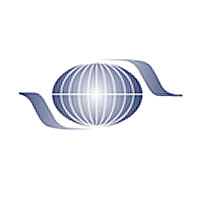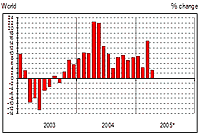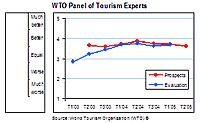“People are regaining the lust for travel and feel that the moment is appropriate to make the trips they postponed in the past years.” |
|
The WTO said that a key driver of travel growth was the stimulating effect of “tempting” offers made available by online travel services, including low-cost airlines |
INTERNATIONAL. International tourist arrivals grew by +8% in the first four months of 2005, according to the recently-released June edition of the World Tourism Organization’s (WTO) World Tourism Barometer.
As a result, worldwide tourism results for 2005 to date show a continuation of the overall positive trend of 2004, the WTO said.
“Although the excellent pace of growth of 2004 was expected to slow down gradually, for the moment rates are very similar to those seen in the second half of 2004, a year in which international tourist arrivals grew by more than +10% to an all-time record of 763 million,” it added.
“The first few months thus indicate that 2005 is shaping up as a year of continued recovery from the various shocks felt in the 2001-2003 period. Pent-up demand continues to be released as consumer confidence is on the upswing again and the fear factor has faded.”
The WTO said that a key driver of travel growth was the stimulating effect of “tempting” offers made available by online travel services, including low-cost airlines.
WTO Chief of Market Intelligence and Promotion, Mr. Augusto Huéscar commented: “The geopolitical climate, the persistent weak economy and SARS have constrained tourism seriously in previous years and have left a significant amount of pent-up demand in the market. From last year on, we have seen this being released and the data indicates that this process is still in full swing. People are regaining the lust for travel and feel that the moment is appropriate to make the trips they postponed in the past years.”
Positive results in every world region
Positive results are estimated over the first four months of 2005 for all regions, ranging from +5% for Europe to a remarkable +17% for the Middle East.
Growth rates registered in the second half of 2004 are being very well maintained in 2005.The current pace of growth is inevitably slower than that recorded over the full year of 2004, as this was a very atypical year, said the WTO.
As a consequence of the post-SARS and Iraq invasion correction on the depressed 2003 results, the growth rate of the first half of 2004 was exceptional, in particular in the case of Asia Pacific and the Middle East.
“The first few months indicate that 2005 is shaping up as a year of continued recovery from the various shocks felt in the 2001-2003 period. Pent-up demand continues to be released as consumer confidence is on the upswing again and the fear factor has faded.” |
|
International tourist arrivals; monthly evolution. Source: World Tourism Organization (WTO) |
2005 results have been particularly strong in the Middle East (+17%), in Africa (+12%) and in the Americas (+11%). Africa was the only region to exceed the trend of 2004. Due to the improvement of results in the Sub-Saharan part of the region, overall results for the first four months are some four points up on last year.
Africa also received the highest scores for the upcoming period by the WTO Panel of Tourism Experts, followed by the Middle East and the Americas.
2005 results also show that the Americas has continued the strong recovery that began in early 2004, with international tourist arrivals increasing by +11% in the first four months of the year. Asia and the Pacific grew by almost +9% after the excellent results in 2004 (+28%) with overall figures only marginally affected by the tsunami disaster of last December, whereas Europe (+5%), which weathered the 2001-2003 downturn rather well, maintained last year’s positive trend.
Growth in all four months
For January 2005 growth of worldwide international tourist arrivals is estimated at +9% compared to the same month of the previous year. In February, arrivals increased by +4%, but it should be taken into account that 2004 was a leap year and February had one day more, representing some 3% to 4% of the monthly total.
In March, arrivals jumped by +15% boosted by the fact that the Easter holidays fell in March this year and not in April as in 2004. By the same token, this skewed down the April results, which, however, were still positive at +3%. For the four-month period January-April 2005 as a whole, growth amounted to close to +8%.
Upbeat prospects for the high season
Prospects for the forthcoming high season in the northern hemisphere are positive overall, as no major constraints are present and the economic scenario is on the whole favourable.
According to Huéscar “major source markets and destinations are gearing up for the busiest months of the year and no drastic changes are expected in the current momentum”.
On a five-point scale ranging from [1] much worse to [5] much better, representatives of both the public and private sectors gave the period January-April 2005 an average score of 3.7, corresponding in terms of the WTO Panel of Tourism Experts Confidence Index to an evaluation of “better than what would reasonably be expected”. This confirmed the expectations expressed by the panel early in January regarding this period (3.7). Prospects for the next four-month period between May and August are marginally down, but still optimistic overall (3.6) |
|
WTO panel of tourism experts; prospects (red) and evaluation (blue). Source: World Tourism Organization (WTO) |
There is still a significant amount of pending demand, in particular concerning long-haul traffic. Short-term prospects are particularly positive regarding travel out of Europe due to the still strong Euro.
In addition, with more and more intra-regional destinations served by low-cost airlines, tour operators are moving to more exotic medium- and long-haul destinations.
However, independent travel continues to develop faster than conventional package travel fuelled by increased capacity from low-cost airlines and growing online availability of well-priced accommodation.
Outbound tourism from the Americas is expected to maintain its strength, as the US only recently started to recover from the severe drop it suffered in the period 2001-2003.
In 2004, the number of US citizens travelling by air to overseas regions, Canada and Mexico increased by +14%. However, they are only slowly returning to Europe and are expected to continue being more attracted to destinations within their own region or in Asia and the Pacific, where the impact of the weak US dollar is less significant.
Asia and the Pacific, the Middle East and Africa are expected to continue to post strong results, both from outside the region and from intra-regional source markets.
The over 230 specialists from around 100 countries and territories who contributed to the WTO Panel of Tourism Experts for this edition of the WTO World Tourism Barometer maintained their positive evaluation regarding the first four months of 2005 as well as for the forthcoming period (May-August 2005).
On a five-point scale ranging from [1] much worse to [5] much better, representatives of both the public and private sectors gave the period January-April 2005 an average score of 3.7, corresponding in terms of the WTO Panel of Tourism Experts Confidence Index to an evaluation of “better than what would reasonably be expected”. This confirmed the expectations expressed by the panel early in January regarding this period (3.7). Prospects for the next four-month period between May and August are marginally down, but still optimistic overall (3.6).
MORE ON THE WORLD TOURISM ORGANIZATION
China’s star shines bright in latest World Tourism Organization rankings – 20/05/05







